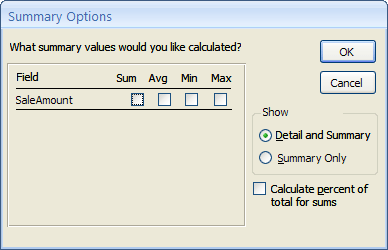

There is no need to repeat the expression (e.g. VarPercentage = curAmountPaid / curTotalAmount Next, you don’t have to worry about balancing parentheses and square brackets as VBA allows you to write the same expression above but simply, like this:
EXAMPLE OF MICROSOFT ACCESS REPORT SUM CODE
For one, you can easily debug VBA code to aid validating the logic or the result. Creating custom access formulas and functions in VBA offer several advantages over using expressions. Unfortunately, sometimes the expressions are much messier than the tidy examples I showed so far.Īs of late, I’ve come to appreciate using custom functions rather than expressions. I don’t know about you but whenever I inherit a database that is heavy with expressions like those, it can be quite a chore to go through the expressions and think about the path it takes to arrive at the result, which slows down my troubleshooting or understanding of what this is going on within the form. But it’s no longer straightforward to read. Several people work around this problem by doing this instead: For example, what happens if the InvoiceAmount adds up to $0? We would, of course, get a division by zero error which is then shown as #Div/0!. This will work but not exactly without hitches. We might need to calculate a percentage, which would be expressed as: Now, sometimes, we don’t have simple requirements. For example, showing a sum of some column can be as simple as putting down: MS Access has a very powerful support for using expressions in your forms/reports’ controls.
EXAMPLE OF MICROSOFT ACCESS REPORT SUM SOFTWARE

Convert ADP file to ACCDB (regular Access file).Enable Microsoft Access to work from home.



 0 kommentar(er)
0 kommentar(er)
